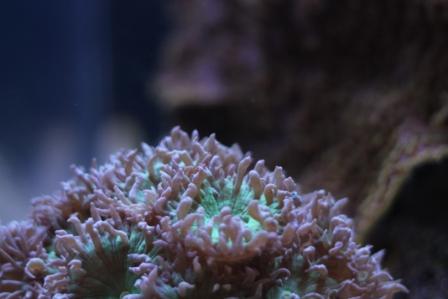The Duncan coral, duncanopsammia axifuga, has large, fleshy polyps and looks a little bit like a zoanthid or other button polyp species, but it is really a large polyp stony (LPS) coral. They are sometimes also called whisker coral or daisy coral.
Like all LPS corals, Duncans have a calcified stony skeleton and therefore require relatively high concentrations of calcium, magnesium, and hardness, measured as dKH, to stay healthy.

A quality reef aquarium salt will naturally have a good concentration of these important elements, but you should test your water to monitor these water parameters to ensure your tank stays within a healthy range.
If your tank falls out of the healthy range, you can generally restore the quality of the water by performing water changes or adding reef supplements, like 2-part, if necessary. You can see parts of the exposed skeleton in the image above, where the Duncan coral polyp has died away
Individual polyp heads will grow out from a central stalk in a bouquet-like arrangement, as can be seen in the image below of a Duncan coral taken at the New England Aquarium, in Boston.

Are Duncan corals easy to keep?
Duncan corals are easy to keep in an aquarium because they are hardy and grow well in relatively lower light and water flow areas. They are often one of the first LPS coral types added to a reef tank.
Where should Duncan corals be placed?
The ideal placement for Duncan corals is towards the bottom of the tank, even in the sand bed in the lower-light, slower water flow areas of the tank. They do not need high flow.
Are Duncan corals fast growing?
The Duncan coral is a fast-growing corals species that will grow even more quickly if regularly fed.
Are they aggressive?
Duncan corals are not aggressive. They are peaceful corals that will share the tank space well with other peaceful corals. Since they are fast-growing, be sure to give them ample space to grow so that they do not crowd out neighboring corals.
Can they touch a Torch coral or other aggressive species?
Do not place a Duncan coral somewhere they will be in physical contact with, or even too close to aggressive coral species like the Torch coral. Aggressive corals will injure or destroy this peaceful coral.
Do they need to be fed?
These are photosynthetic corals that can provide themselves with all the nutrition needed, but they will grow faster and fuller if they are fed routinely. These large polyp stony corals can take large meaty foods, as long as the fish don’t steal the meal first.
Duncan corals are a popular reef aquarium species
One of the reasons these are popular corals is that low-to-moderate lighting is all that is required to keep these amazing animals. This is a deepwater species that comes from low-current reefs around Australia and the South China Sea.
They also have symbiotic zooxanthellae and are photosynthetic, but they are also hunters, capable of capturing and eating prey, and will benefit from regular feedings of brine shrimp, mysid shrimp, cyclops, or small pieces of shellfish.
In the center of the large, fleshy polyps is a mouth, where the food items would be ingested and consumed. Target the mouth when directly feeding this coral. A great aquarium tool to target feed the Duncan coral is Julian’s Thing, which is a long pipette, that will allow you to gently drop a meaty morsel right on the mouth.
Duncan coral grows rapidly, especially when fed well, so when you are picking a location in your tank for that new frag you bought, be sure to give them plenty of room to grow into your reef.
Several years ago, Duncans were not that popular here in the U.S., but these corals are now aquacultured and have become a staple in the aquarium trade.

Fragging the Duncan coral
The Duncan coral is relatively easy to frag. The short, stony branches can be easily cut with bone shears or a Dremel tool, and then attach the bottom of the stony stalk to a small piece of live rock with cyanoacrylate glue. For more step-by-step instructions about how to frag Large Polyp Stony corals like these and other corals, get the book: How to Frag Corals on Amazon or iTunes today.
Do you dip Duncan corals?
You should dip your Duncan corals before adding them to your display tank, to protect from introducing unwanted pests into the tank.
What kind of coral is a Duncan?
The Duncan coral is a Large Polyp Stony coral with a calcified skeleton and large fleshy polyps.
Other large polyp stony corals
There are many other large polyp stony corals. To learn more, learn how to care for these other popular LPS too:
- Torch coral care
- Acan coral
- Gonipora
- Favia coral
- Hammer coral care
- Elegance coral
- Blastomussa
- Galaxea coral
For more information
For more information like this post, check out:
Or check out this definitive guide about aquarium corals for more information.


Leave a Reply